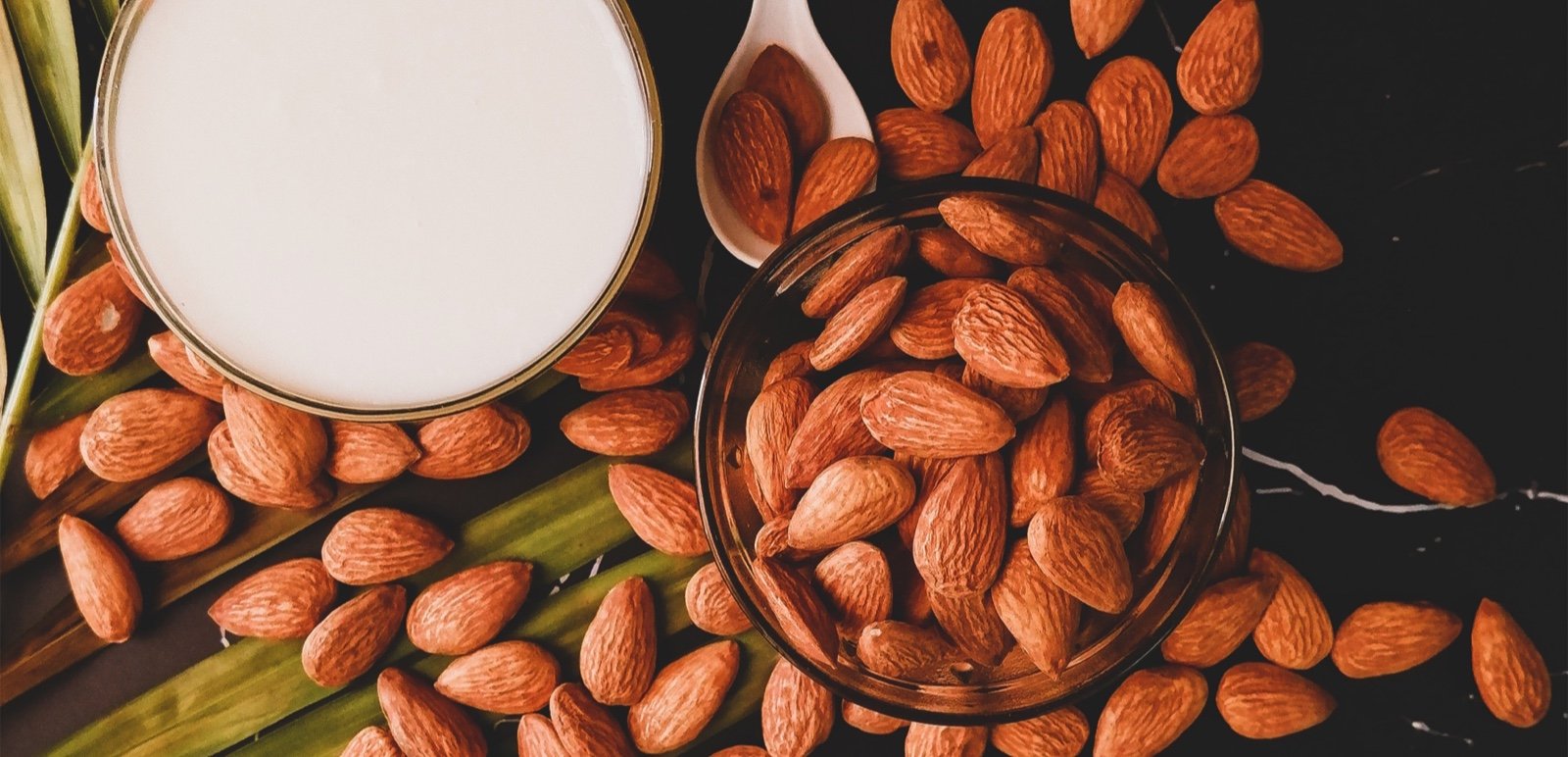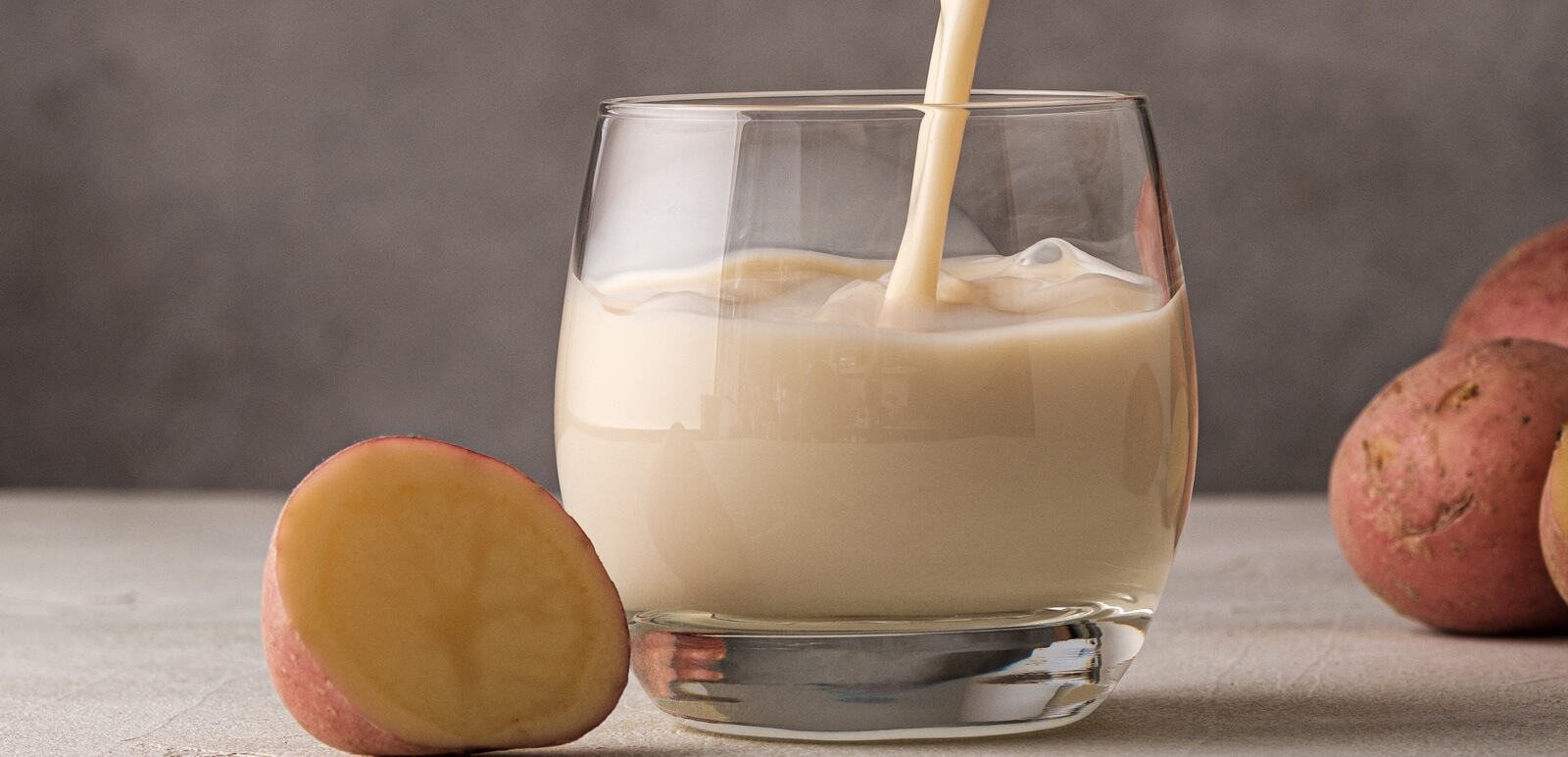Two spud lattes, please: what’s big in plant milk for 2022
Do you need potato milk in your life? This article takes you through soy, almond, oat, all the way to pea and potato. The battle of the plant milks has begun!

The potato is beloved, holy almost. What other vegetable represents such comfort, such delight, in all its many forms? But it’s not crispy roast potato, or garlicky mash that’s in the news right now. No, it’s a potato milk that’s in the headlines and hitting the shelves at major supermarkets in the UK.
Billed as a viable alternative to dairy, with foaming properties and a creamy texture, 2022 could be the year of the potato. Or, in this age of ever-evolving plant milk varieties, it could be the year that almond and oat continue their reign, or where soy takes back its lead. Perhaps pea, coconut, and rice will RISE through the ranks, or maybe on-trend hemp will surprise us with a surge. Yes folks: in the battle of the plant milks - or, mylks - things are about to get interesting.
The current market breakdown

Current numbers are still in flux, but in 2019, Dairy Australia reported that milk substitutes made up about 9.2 per cent of the dairy market in Australia. This is due to more plant-based eating across the population, awareness of sustainable frameworks, and more varieties appealing to individual preferences.
“10 years ago, soy milk was the only option” says Lauren Chapman, founder and CEO of h.alt, a specialty Australian hemp milk brand. “But, with more milks joining the market, consumers can take their pick.”
While it’s true that soy milk now has many challengers, it still represented 47.6 percent of the Australian alternative milk market in 2020, with almond milk coming second. According to IRI data, almond milk holds 22 per cent of the non-dairy milk market - a figure that’s up 1.5 per cent versus the previous year.
“The most popular alt milk in 2022 will still be almond, but the gap is closing,” says Brendan Stanton, Founder of Happy Moo Distribution. He believes almond milk will continue to rise in popularity, which is in line with stats from IBIS world that estimate the Australian revenue of the soy and almond milk industry will be $432.6 million in 2022.
Oat and almond racing ahead
However, Stanton also observes his more and more of his venue customers are turning towards oat milk. “Customers have been buying more oat milk. It’s becoming popular as its smoother and creamier than the almond and soy…and it doesn’t have much of an aftertaste.”
But taste and texture pale in relation to concerns around sustainability. Almond milk is popular, but growing almonds sucks up resources, with 73 litres of water required to produce a single glass of almond milk. “Some cafes don’t stock almond milk full stop because of this fact,” says Stanton.
Oat, in contrast, shines bright on sustainability metrics. Oats are grown in cooler climates and are not associated with deforestation and can be grown on existing acreage. The downsides could be the amount of greenhouse gas-emitting fertiliser required to grow oat crops.
The rise of niche plant milks

The carbon footprint of oat milk is a legitimate concern, which is why proponents of other milks say that oat should be forgone in favour of other milks such as hemp. “There’s been a rise in general interest in hemp-based products over the past 18 months,” says Lauren Chapman. “This interest is largely from people committed to vegan & sustainable food products.”
She points out that hemp milk also has a neutral, appealing taste - and performs better in coffee than more well-known plant milks. “When people taste it, their attitude is one of disbelief and they want to tell others of their discovery….I’ve even heard from baristas that soy is their least favourite milk to steam as it reacts poorly with the coffee.”
Coffee compatibility is paramount for a milk to go mainstream in Australia: when it comes to our beloved morning brew, few milks - or mylks - have been able to compete with the frothy smoothness of dairy.
This has been changing, with plant milk brands like MilkLab formulating barista-only milks to combat any coffee concerns, and newer brands doing intense product research and experimentation before they go to market.
Robust marketing and outreach means more cafes and baristas are becoming aware, and are happy to use, plant milks that aren’t the usual soy, almond, and oat. These days, it’s not unusual to see lesser-known milks like hemp, macadamia, cashew, and even pea, popping up in flat whites and cappuccinos.
It’s this consistent product development and marketing, as well as the focus on both health and environmental benefits, that will see plant milk culture continue to evolve in 2022.
“There will be new and existing players that will add or create alternative milk portfolios in the coming years. They will look to fill the void of the alt milk that they don’t currently have, and they’ll try to get a piece of the action,” says Stanton.
What about potato milk?
We’re now across the state of plant milk in Australia - but what of the potato and its not-so-appealing milk? Will it really become a thing in 2022? Experts say that the focus of suppliers and venues in the near future will be on the better known plant milks, but that interest is piquing in more niche, sustainable varieties that pair well with coffee and other hot drinks. These new milks will add variety and colour to menus, but it might take a couple of years for them to go mainstream.
So while potato milk might not be used over your morning cereal anytime soon, if the push in overseas markets is anything to go by, you could see a spud latte on a trendy cafe menu before the end of the year is through.
We compare plant milks

Soy milk
Soy milk is high in protein, has a nutty, distinct taste, and is denser than other milk alternatives. While soy won’t stretch the way dairy milk does, there are many barista-friendly soy milks on the market, and it’s still the best known alternative.
Nutritionally, soy is high in protein in comparison with other plant milks, and is rich in omega-3 fatty acids.
From an environmental perspective, soy uses much less water than other plant milks, although vast areas of the Amazon have been cleared to grow soybeans, destroying vital ecosystems. It’s best to stick to soy milk made from Australian soybeans to minimise the carbon footprint.
Almond milk
Almond milk has a naturally bitter taste (some products are sweetened to override this) and a very low fat content which can make it hard to work with in a coffee context.
Some almond milks contain as little as two per cent almonds, which are ground and soaked to make the milk. The rest of the product might just be water. There are barista friendly almond milks that have a higher fat content and are slightly thicker to provide some creaminess.
From an environmental point of view, almond milk uses up a lot of water which makes it one of the least sustainable plant milks. A glass of almond milk requires more than 70 litres of water to produce. Almond crops also require a lot of pesticides, and in California, where 80 percent of the world’s almonds are grown, bees are dying, and it’s likely because of the amount of pesticides used. To counteract this problem, choose brands using Australian almonds.
Oat milk
Oat is rising very fast in popularity - and is the most heavily consumed alternative milk in many countries. The pluses are that it’s the only plant milk to contain fibre, and it’s also low in fat. It’s also naturally sweet which means it blends well with certain types of coffee. Additionally, it thickens when it gets heated making it the perfect base for many hot drinks.
The low impact of oat milk on the environment is another positive, but right now most oat production is for livestock and grown in large scale crops in North America. This has an effect on the natural ecosystems, so as with most sustainable decisions, it’s best to go local.
Hemp milk
Hemp only became legal as food in 2017 - which is a shame considering the benefits of this hardy crop. Hemp doesn’t need pesticides and consumes much less water than nuts and other legumes. Right now, hemp is grown in smaller quantities which makes it an environmentally friendlier option.
The hemp plant has many different uses, and the non-psychoactive seeds produce a milk that’s rich in protein and healthy fats. It’s low in saturated fats, there’s no sugar or cholesterol, and it’s very high in omega-3.
“It has a creamy taste and rich silky texture, which makes people keep coming back for more,” says h.alt’s Lauren Chapman.
The high protein content means you can froth it, making it a viable coffee partner, and some sources say it has a similar stretch to soy.
Coconut milk
Coconut milk has been used in cooking for a long time, and is made from grated coconut flesh and water. It’s got a high fat content, it’s low in protein, and it doesn’t work well with temperatures above 60 degrees. Additionally, it’s got a very strong flavour which may overpower the taste. Some brands add sugar, which further strengthens the flavour.
In terms of the environment, coconut farming doesn’t require a huge amount of land, but the higher the demand, the more likely deforestation will occur.
Macadamia milk
Creamy, nutty macadamia milk is one of the sweeter, more indulgent plant milks, and it’s easy to texture for coffee. Some people enjoy the flavour whereas some feel it can be overpowering.
The good thing about macadamia milk is that it’s low in calories, but has a high fat content.
The amount of water needed to produce macadamia milk is much lower than that of almond milk, mainly because macadamias are grown in climates where it rains more. However, if the countries where macadamias are grown changes (eg. Australia, Hawaii), this could mean heavy water consumption to produce each cup.
Rice milk
Rice milk has a thin consistency and often contains a lot of sugar. It’s made from milled brown rice blended with water and has high levels of carbs compared to other plant milks. It has no protein and no saturated fat, and has a high glycaemic index. It’s excellent for consumers with reactive or sensitive stomachs as it’s very low in allergens.
Environmentally, rice milk isn’t quite as thirsty as almond milk, but it’s a greenhouse gas contributor because the root of the plant develop a bacteria that emits methane.
Pea milk
While some might be expecting a pea-like flavour, pea milk has a similar taste profile to almond milk, with a more creamy texture. Unsweetened pea milk has a good health profile but many varieties include sugar.
It’s made from green and yellow split peas and the fibre and starch has been removed. Many people find they prefer to use pea milk in cooking rather than in hot drinks, but new iterations might be different.
Peas grow well without nitrogen fertiliser and are said to be lower emitters of greenhouse gases than other milks, but there are few independent reports on the sustainability of pea milk.
Potato milk
The idea of potato milk has people wrinkling their noses, but the humble spud doesn’t have a strong flavour, and the resulting milk is creamy and supposedly doesn’t curdle when heated. Many people say that it works well with coffee, as well as being low in allergens.
For the eco-conscious, growing potatoes takes up about half as much land as growing oats, and uses 1/56th as much water as almonds. Potatoes are very hardy, meaning they need less fertiliser, and can be grown nearly anywhere in the world. They’re the most sustainable plant milk option by far, which is why there’s so much noise around this well-loved vegetable.
Looking for a your next plant milk supplier? Download the Ordermentum app now, and find your next oat, almond, hemp - or perhaps potato - supplier.
Categories
Trends
Food lover, restaurant-goer, hospitality appreciator, and writer of content at Ordermentum.


.png?width=352&name=Ali_NasseriL1000926%20(800x479px).png)




